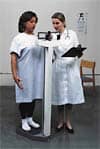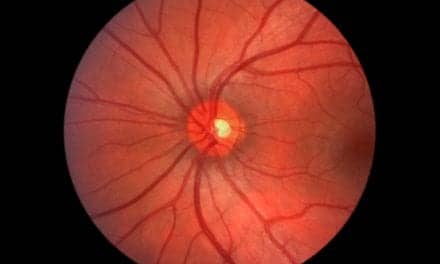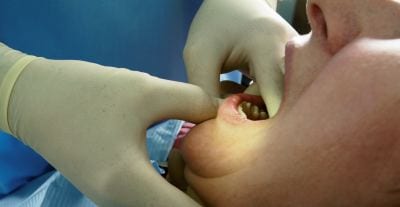Pulmonary Hypertension and Sleep Apnea: How Important is the Connection?

She described significant daytime sleepiness, with an Epworth score of 18. Bedtime was 10 pm, sleep latency was short, and she got out of bed at about 7 am. She was described by her partner as a severe snorer, and apnea had been observed during her sleep on occasion.
Medical history included coronary disease with previous stent placement, gastroesophageal reflux disease, hypothyroidism, and hypertension. Family history is remarkable for her mother, who was a severe snorer, and the patient had a niece with sleep apnea.
On examination, blood pressure was 176/90, pulse: 83, oxygen saturation: 94%, weight: 224 pounds, and height: 63 inches. The oropharynx was moderately crowded, with a redundant soft palate; she had a Mallampati score of 3; her chest was clear; cardiac examination was unremarkable; and extremities were without edema.
Pulmonary function testing was normal, and a methacholine challenge was negative. A chest CT showed a small nodule, while lung parenchyma was otherwise normal.
Cardiac catheterization was performed for unexplained dyspnea. The left ventricular function was normal, and no progression of coronary disease was seen; left ventricular end diastolic pressure=16, pulmonary capillary wedge pressure (PCWP)=14, pulmonary artery pressure 40/16 with a mean of 23 mm Hg, indicating pulmonary hypertension.
Overnight polysomnography showed moderately severe sleep-disordered breathing, RDI=42/h, and moderate desaturation, with 5% of sleep time below 90% saturation.
So, what is the significance and etiology, of pulmonary hypertension in this patient?
OSA is a commonly underdiagnosed illness with a significant negative impact on health, and a high prevalence in the general population. Pulmonary hypertension is also a commonly underdiagnosed illness, but is not common. The possibility that OSA could cause pulmonary hypertension has been considered for nearly 20 years, and the connection between the two illnesses may shed light onto the pathophysiology of both diseases. It is likely that although pulmonary hypertension is relatively common in patients with OSA, the severity of pulmonary hypertension in these patients is generally mild.
OSA is clearly a major risk factor for cardiovascular morbidity. Data emerging from the Sleep Heart Health Study showed that sleep apnea is an independent risk factor for coronary artery disease, congestive heart failure, and stroke even at modest levels of severity.1 The prevalence of sleep-disordered breathing is estimated at anywhere between 2% and 4% of the adult population. The disease is more common in males than in females, and clearly more common in patients who are overweight.
|
Pulmonary Hypertension
Pulmonary hypertension, on the other hand, is a relatively rare disease. Primary pulmonary hypertension has a prevalence of 1 to 2 per million in the population, with a female predominance of 1.7 to 1. Mean age at diagnosis is 40, and there is no direct association with obesity. The nomenclature for pulmonary hypertension has been recently revised (Table 1, page 22), and is now categorized as pulmonary arterial hypertension (sporadic or familial), pulmonary venous hypertension, pulmonary hypertension with hypoxemia, chronic thromboembolism, and miscellaneous disorders. Sleep-disordered breathing is listed as one of the causes of pulmonary hypertension with hypoxemia (Table 2, page 22). In the National Institutes of Health Registry, patients with pulmonary hypertension are defined as having mean pulmonary artery pressure >20, but most patients are in the 40 to 80 range.
|
OSA may induce acute pulmonary hypertension by means of one of three possible mechanisms. First, the hypoxemia associated with apneas may induce hypoxic pulmonary vasoconstriction. Hypercapnia may also induce the constriction. Finally, large negative intrathoracic pressure swings may be responsible. Sustained pulmonary hypertension has been found in anywhere from 10% to 79% of patients with OSA. These estimates vary according to the method used to assess pulmonary hypertension (right heart catheterization, echocardiogram, or clinical). To assess true “precapillary” pulmonary hypertension, it is necessary to measure PCWP. It is also important to exclude significant lung disease as a cause of pulmonary hypertension.
Chaouat et al2 in 1996 reported 220 consecutive patients with OSA as defined as AHI >20. All patients had right heart catheterization. Pulmonary hypertension, defined as a mean pulmonary artery pressure Ž20, was found in 17%. In these patients, however, there was significantly worsened lung function and more daytime hypoxemia than in patients with normal coronary artery pressures. There was, in fact, a better correlation with indices of pulmonary function and arterial blood gases than with apnea index or AHI.
In 1999, Sajkov et al3 reported on 32 patients with AHI >10, normal pulmonary function, and no known cardiovascular disease. Pulmonary artery pressure was estimated by Doppler echocardiography, and response to hypoxia, hyperoxia, and dobutamine was measured. Eleven patients had elevated pulmonary artery pressures. These patients had a marked increase in pulmonary artery pressure when blood flow was increased by dobutamine, suggesting pulmonary vascular remodeling and an increased response to hypoxia. The authors also found more small airways closure during tidal breathing. They hypothesized that repetitive sleep hypoxemia might lead to pulmonary hypertension and vascular remodeling. Small airways closure might result from obesity, ventilation perfusion inequalities, and alveolar hypoxemia. Pulmonary hypertension could thus directly cause small airways dysfunction.
In a follow-up paper in 2002,4 the same group showed that CPAP improved pulmonary hemodynamics. Mean pulmonary artery pressure declined in all patients with sleep apnea, with the greatest change seen in those with pulmonary hypertension.
In 2000, a paper by Bady et al5 looked at 44 patients with an apnea index greater than 5 and no chronic obstructive lung disease. In this group, 27% had pulmonary hypertension, defined as a mean pulmonary artery pressure >20 and PCWP <15. There was no correlation with apnea index, but patients with pulmonary hypertension were more likely to have lower daytime and nighttime oxygen levels, a higher body mass index, and worse pulmonary function.
Alchanatis et al6 followed 29 patients with AHI >15, and no lung or heart disease. Pulmonary artery pressure was estimated by Doppler echocardiography before and after 6 months of CPAP treatment. There was a significant improvement in pulmonary artery pressure measurements in both patients with pulmonary hypertension and those without.
Nineteen patients with AHI >11 had polysomnography with pulmonary artery pressure monitoring in a study by Niijima et al.7 These patients were not selected for an absence of lung disease; 10 had waking pulmonary artery pressures >20, and these had a significantly lower forced vital capacity, higher Pco2, and higher body mass index. In patients with daytime pulmonary hypertension, the response to hypoxemia was significantly greater during REM than non-REM sleep. The authors suggested that REM increases in pulmonary artery pressure occur in patients who already have increased vascular tone.
Conclusion
In summary, the available literature suggests that perhaps 20% of patients with OSA have pulmonary artery hypertension. The pulmonary hypertension in these patients appears to be generally mild. Pulmonary pressures correlate more with pulmonary function, obesity, and hypoxemia than with sleep variables. REM sleep may be particularly important in the etiology of pulmonary hypertension. Vascular remodeling may be taking place. The most important news may be that the pulmonary hypertension seen with OSA does appear to be reversible on treatment with CPAP.
The finding that pulmonary artery tension in sleep apnea may be associated with mild pulmonary function changes is further complicated by the possibility that pulmonary hypertension itself causes abnormal pulmonary function. In a series reported by our group, in 60 patients with primary pulmonary hypertension but no history of cardiac or pulmonary disease, 55% had abnormal FEF25%-75%, and 36% had a bronchodilator response.8
It is perhaps not surprising that pulmonary hypertension might be seen in patients with OSA. The pathogenesis of pulmonary artery hypertension is thought to be the activation of vascular pathogenic mediators leading to vascular wall remodeling. There is increasing evidence that OSA is associated with increases in adhesion molecules such as ICAM-1 and selectin,9 vascular endothelium growth factor,10 and NF kappa B. Endothelin-1 has been shown to increase after 4 hours of untreated sleep apnea, and decrease after 5 hours of CPAP treatment.11 Endothelin-1 is a major cause of vasoconstriction and myocyte hypertrophy in pulmonary hypertension.
What, if anything, does this mean clinically? Although pulmonary hypertension may be common in sleep apnea patients, it is rarely evident and may not be important clinically. Routine echocardiography is probably not indicated. It is also not necessarily appropriate for all patients with pulmonary hypertension to have polysomnography; however, if primary pulmonary hypertension is present in fewer than two per million of the general population, sleep-disordered breathing is present in 4%, or 40,000 out of 1 million, and 20% of patients with sleep apnea have pulmonary hypertension, this would mean that the prevalence of pulmonary hypertension from sleep apnea is several thousand times higher than the prevalence of primary pulmonary hypertension.
The patient described above has pulmonary hypertension in the fairly mild range typical of patients with sleep-disordered breathing. She has not yet been studied after treatment to quantify the effect of treatment on her pulmonary artery pressures. Her pulmonary hypertension is likely to improve, but it is not clear whether her dyspnea will be affected.
Steven H. Feinsilver, MD, FCCP, FAASM, is director, Pulmonary and Sleep Medicine, Cardiovascular Medical Associates, Garden City, NY, and associate professor of medicine (clinical) at New York University School of Medicine, New York.
References
1. Shahar E, Whitney CW, Redline S, et al. Sleep disordered breathing and cardiovascular disease: cross-sectional results of the Sleep Heart Health Study. Am J Resp Crit Care Med. 2001;163:19-25.
2. Chaouat A, Weitzenblum E, Krieger J, Oswald M, Kessler R. Pulmonary hemodynamics in the obstructive sleep apnea syndrome. Chest. 1996;109:380-386.
3. Sajkov D, Wang T, Saunders NA, Bune AJ, Neill AM, Douglas Mcevoy R. Daytime pulmonary hemodynamics in patients with obstructive sleep apnea without lung disease. Am J Resp Crit Care Med. 1999;159:1518-1526.
4. Sajkov D, Wang T, Saunders NA, Bune AJ, Mcevoy RD. Continuous positive airway pressure treatment improves pulmonary hemodynamics in patients with obstructive sleep apnea. Am J Resp Crit Care Med. 2002;165:152-158.
5. Bady E, Achkar A, Pascal S, Orvoen-Frija E, Laaban JP. Pulmonary arterial hypertension in patients with sleep apnoea syndrome. Thorax. 2000;55:934-939.
6. Alchanatis M, Tourkohoriti G, Kakouros S, Kosmas E, Podaras S, Jordanoglou JB. Daytime pulmonary hypertension in patients with obstructive sleep apnea. Respiration. 2001;68:566-572.
7. Niijima M, Kimura H, Edo H, et al. Manifestation of pulmonary hypertension during REM sleep in obstructive sleep apnea syndrome. Am J Resp Crit Care Med. 1999;159:1766-1772.
8. Kyprianou A, London D, Padilla M, et al. Small airway disease, air trapping and airways responsiveness in patients with primary pulmonary hypertension. Chest. 2003;124:S222.
9. Ohga E, Nagase T, Tomita T, et al. Increased levels of circulating ICAM-1, VCAM-1, and L-selectin in obstructive sleep apnea syndrome. J Appl Physiol. 1999;87:10-14.
10. Lavie P, Kraiczi H, Hefetz A, et al. Plasma vascular endothelial growth factor in sleep apnea syndrome: effects of nasal continuous positive air pressure treatment. Am J Resp Crit Care Med 2002;165:934-939.
11. Phillips BG, Narkiewicz K, Pesek CA, Haynes WG, Dyken ME, Somers VK. Effects of obstructive sleep apnea on endothelin-1 and blood pressure. J Hypertens. 1999;17:61-66.





